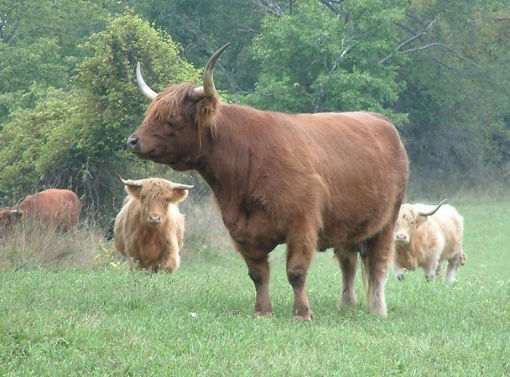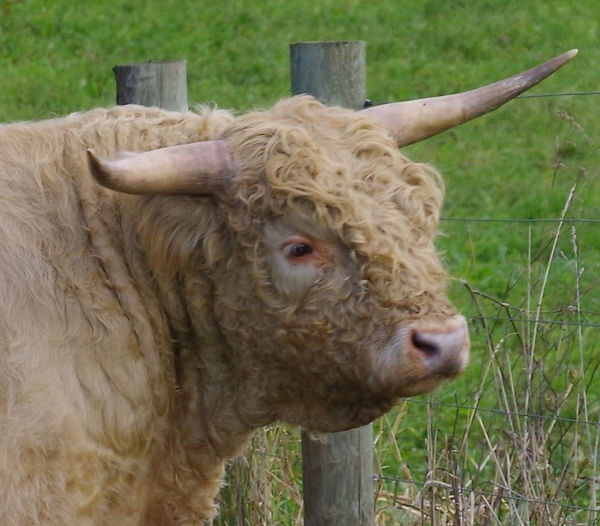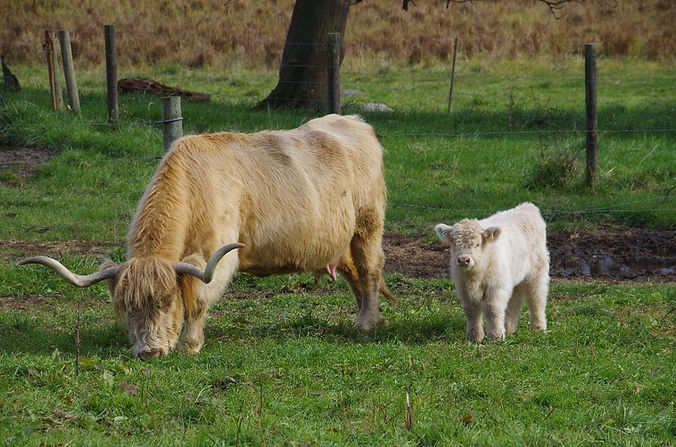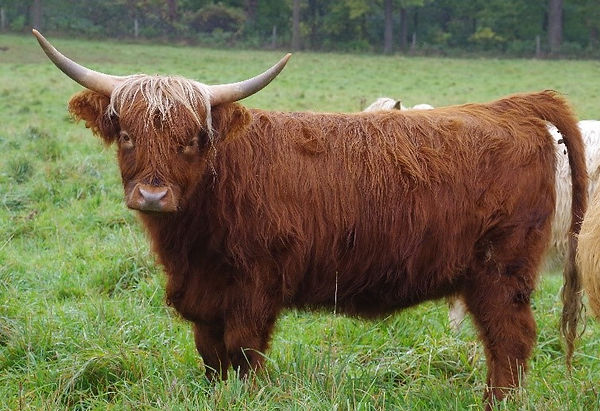
Color in cattle can be a very confusing subject if you don’t have a feel for genetics and you don’t know what colors are “normal” or accepted for the Highland breed. Presently there are 7 colors accepted for registration in the American Highland Cattle Association. Those are black, dun, silver, red, yellow, white and brindle. Parti-color is accepted for registration of females only and is really only a designation of excessive spots of a color on a base of a different color, and does not address what those base colors may be (such as white spots on black, white spots on red, etc. At this time parti-color females are not permitted to be shown in any AHCA sanctioned show and parti-color males may not be registered in the American herdbook.
Determination of Color:
A chromosome is a bundle of DNA found within the cell that codes for a multitude of genetic traits. A gene is the part of a chromosome that is responsible for producing some specific function, (in this case, coat color) in the organism. An allele is a variant or mutation of the gene that effects the same function but with a different result (black vs red for example). So, a chromosome will have a multitude of genes within it; each gene may have a number of variations (alleles) of which usually only two can be found on the normal chromosome at one time, and the locus is the location on the chromosome where the specific gene is found. Each locus has a name, each gene has a name and each allele has a specific designation. The gene controlling black/red color is the MC1R gene (melanocortin 1 receptor), at locus E (extension). The gene controlling the deletion or dilution of color is the PMEL or SILV gene {premelanosome protein (PMEL) or silver locus protein homolog (SILV)} at the locus D (Dilute). The gene that causes brindling in Highlands is the ASIP (Agouti Signaling Protein) gene at locus A called Agouti.
The basic coat colors are determined by only two genes: one controls whether the base color is black (ED) or red (e) or wild-type (original) red (E+) , the other controls whether that base color is diluted (D)or not diluted (d or +). A separate gene controls brindling (either A+ or Abr ) in combination with wild-type red (E+) and in Highlands and may or may not be evident to the observer because the presence of dominant black (ED) will mask all evidence of brindling as will homozygous recessive red.. Brindle coloration requires at least one wild type red ( E+) combined with the brindling gene Abr. There is a recessive allele a at the A locus, which will produce recessive black if homozygous for that allele. However, to my knowledge, the presence of this allele has not been confirmed in Highland cattle.
The MC1R gene is responsible for some interesting effects in addition to determining color. In humans, it is a mutation on this gene that codes for red hair and it is mutations on this gene that are attributed to people with red hair requiring higher doses of anesthesia in order to be rendered unaffected by the pain of surgery. (both general anesthesia and local anesthesia.) This may also be true of red colored dogs.
Each parent contributes one allele from each of the genes so that all Highland cattle will have 2 alleles of the E variety (ED , e or E+ ) in any combination, and two genes of the D variety (D or d). Again, ED is dominant black. Only one copy of ED will produce a black colored animal regardless of whether the second gene at that particular locus is ED E+ or e. The second locus is called D, for dilution or deletion, The alleles at the Dilute locus are actually co- dominant to each other, so that a single copy of the D allele will have some effect on diluting coat color, but the other allele also has some effect here, in preventing complete dilution (Dd) The presence of the Dilute allele is completely dominant over the colors produced as a result of the MC1R gene so that the dilution allele will always affect color, whether black or red.
So, a black Highland will genetically be either ED/ ED, ED/ e, or ED/E+ and will carry no dominant dilution (dd) allele . These cattle will be indistinguishable on the hoof. They will all be black cattle. Genetically they will be described as (ED/ ED ,d/d)or (ED/e, d/d) or (EDE+, d/d). In Highland cattle, dun is a dilution of black, so that dun cattle will carry any of the above combinations of the MC1R (Extension) alleles and will also carry one dominant D at the D or dilute locus. { (ED/ED ,D/d) or (ED/e,D/d) or (ED/E+,D/d)} .Silver is a double dilution of black so that silver cattle will carry any of the above combinations producing black, and will also carry two dominant Ds at the D locus. { (ED/ED ,D/D) or (ED/e, D/D)or (ED/E+,D/D)}. Dun in Dexter cattle is a totally unrelated gene.
The two alleles that create red cattle are the recessive red e and the wild-type E+ without the presence of any dominant dilution allele. The wild-type allele is dominant to e, and is believed to be a neutral allele, permitting other genes to control the color expressed. It allows both both black and red color at the same time (brindle stripes) when accompanied by the brindle allele on the Agouti locus (Abr) . So, just looking at a red Highland, they should genetically be ( E+/E+ d/d) or (E+/e d/d) or (e/e d/d). Yellow cattle will have a single co-dominant dilution allele, so will genetically be any of the red genotypes above, with a single co-dominant D. {( E+/E+ D/d) or (E+/e D/d) or (e/e D/d)}. White cattle will have two dilution alleles and will genetically be any of the red genotypes above. {( E+/E+ D/D) or (E+/e D/D) or (e/e D/D)}. White in other breeds is not always due to the same combination of alleles. Charolais cattle have a different mutation on the PMEL gene that produces Charolais white and Shorthorn white occurs due to a mutation in a totally different gene.
To confuse the issue, the A locus (agouti locus) may affect those animals that appear red. The two alleles confirmed at this location in Highland cattle are A and Abr The Abr allele is required to produce brindle cattle but will only manifest itself if those red colored cattle carry the wild-type allele E+. Any cattle carrying a single dominant black gene ED cannot be brindle, even though they may carry the necessary other alleles and may pass those on to their offspring. Black, dun and silver totally mask the alleles necessary to produce brindle. Red cattle carrying two copies of the Abr allele may well be responsible for those cattle carrying very distinct and dramatic brindling while those with a single copy may be less dramatic and even difficult to determine as brindle, particularly in a long haircoat.

Black and its dilutions
Black cattle all carry at least one black ED allele and may carry two. (The term homozygous black refers to an animal carrying two dominant black alleles at the Extension locus. They can only pass a black allele to their offspring, and thus can only produce black cattle or those colors that are a result of the dilution allele acting on black. (dun or silver).) Black cattle may have reddish tips to their coats and may actually be born red, but mature to black.


A black calf with a fringe of red on her ears, poll , tail and back legs. It is unknown if the presence of reddish highlights on an otherwise black animal is genetic or the effect of sunlight bleaching the hair, or maybe some of each.
This calf has an extensive overlay of red guard hairs. She will be black at maturity, as is evident by looking at her head.
Dun colored cattle carry at least one black or ED allele. Black will be dominant to red so only one allele is necessary for the animal to appear black. Dun cattle also carry one dominant Dilute allele D. This moderates black to become dun. They may also carry two black alleles, but must have a Dilute allele on top of black to produce the dun coloration.
A dun calf often is born a gorgeous steel gray; it seems they rarely stay this beautiful shade, but instead molt into a mousy grey/brown. Despite this disparaging description of the color, dun remains my favorite color, it all its incarnations.
The beautiful steel grey dun newborn with his red mother.


Generally, the grey dun will develop into a mousier grayish brown or brownish gray.


This calf is a dun, although could be mistaken for red at birth. At weaning, she has retained a reddish cast to her haircoat and will probably stay this color.



This dun cow retained her much more dramatic red hue into maturity and occasionally passed this particular shade to her offspring. She also has lighter colored stockings on all 4 legs, most evident on the rear legs.
Silver calves also must have either one or two copies of black, but have 2 dilute alleles to act upon that base color. This further dilutes dun to silver. Silver cattle have dark gray noses, gray pigment outlining their eyelids, and dark hooves, but their hair color is white or very pale cream. Silver cattle appear whiter-haired than cattle registered as white, but like white cattle, they often appear a dirtier shade when shed out in the summer.

Silver calves usually are born with obviously white hair, but sometimes will be a pale gray that later changes to white. Here are two calves about the same age. The darker dun colored calf remains a dun, but the lighter gray calf is actually transitioning from light gray to silver. She is shown as a true silver yearling below.

Red and its dilutions:
Red cattle will genetically be either e/e or E+/e or E+ / E+ with no dilution allele. (d/d). Yellow cattle will carry the necessary genetics for red, either e/e , E+/e, or E+/ E+ but will have one dilution allele (D/d ). White cattle, which often appear cream colored, will carry either e/e or E+/e or E+/ E+ and two copies of the dilution allele (D/D).

A near perfect opportunity to show the red family of colors. The bull in the foreground is white (e/e E+/e or E+/ E+ , D/D) the heifer in the middle is yellow (e/e ,E+/e or E+/ E+ , D/d) and the heifer on the right is red (e/e , E+/e or E+/ E+ , d/d). The white bull will always pass a copy of the dilution allele (as both alleles to choose from are D) to his offspring so he can only produce animals with dilute color. The yellow heifer will pass a dilution allele 50% of the time and the red heifer will never pass a dilution allele because she has none to pass. It should be genetically impossible for this red heifer to produce a white or silver offspring; because only a single dilution allele can be donated and only from the sire, as she has none to share.
White cattle can be difficult to differentiate from silver cattle and you need to pay careful attention to the color of the nose pad, the eyelids and the hooves. White cattle will have a pink or pale gray nose pad, pink skin around their eyes and light colored hooves. Silver cattle will have a dark gray nose pad, dark skin around their eyes and dark gray or black hooves.

This white bull actually does have a pale gray nose pad, but if you look at the color of his eyelids it becomes obvious that he is in fact, white.
This silver bull calf has an obviously dark gray nose pad and it is evident that his eyelids are also gray in color, as opposed to the pink eyelids of the white bull above.

Brindle:
Brindle always requires that the Highland animal carry at least one E+ allele. This may then allow the presence of the brindle allele (Abr)on the Agouti locus to affect the pattern of hair color, where both black pigment and red pigment may be present at the same time. However, there are some other genes presently unknown that can affect the manifestation of brindle. Not all cattle with both one E+allele at the E locus and one Abr allele at the Agouti locus will be brindle.

This cow is genotypically e/e, d/d and A/A. She can pass only recessive red, she does not carry the Dilution allele and she is homozygous for the Agouti allele (but not the brindle allele.) She has a black muzzle, the pattern known as Bus Dubh. This color pattern is not indicative of brindle.
The cow below is E+/e d/d, Abr / A. She is dark red with brindling. Her son is untested, but could be the same or with 2 copies of the Abr allele. He is a much more dramatic brindle than his mother.


This solid red heifer actually carries the identical color genetics as the brindle cow above. She too is E+/e d/d, Abr/A however she has no trace of brindle coloration. This did not change as she aged and she matured into a solid red cow. Obviously, there are more color genetics at play here, and presently the genes involved are unknown. (Or perhaps I never found the single black stripe that would have made her a brindle.)
This yellow cow is e/e, D/d, Abr/ A. She carries the gene for brindling, but cannot show it without the wild-type E+ which she does not have. She appears to be very close to white in color. This may be because she is homozygous recessive red, which may be paler than E+/e or E+/ E+ when combined with a single dilution allele.


This white cow is E+/E+ D/D, Abr/ A. Despite carrying both an E+and an Abr allele she does not appear as brindle. Dilute brindles do occur, and are striped yellow with dun, rather than the undiluted brindle that is black and red. However, homozygous dilute brindle would leave white striped with silver and would be virtually impossible to detect. She appears to be almost the same color as the yellow cow above but she carries two dilution alleles.
Frosting and Highlights
Some colors patterns are not specifically identified, and the cattle are generally registered as one of the six solid colors or brindle. The color patterns apparently are on top of the base color of the animal. Such an example is what is most commonly called Frosted cattle. These cattle are usually born apparently solid-colored, but as they become older calves they develop frosting: the top of their head and the tip of their tail always seems to show evidence of frosting, and some of the more dramatic examples will have a ridge of frosting along their topline, and even a heavy overcoat of white hair. Frosting is most commonly associated with a very dark, mahogany red that may appear to be brindled, with the points of frosting being a startling white. As the calves age into maturity, they tend to lose much of the frosting, but the tip of the tail always stays, and generally the poll will retain evidence of frosting. I have seen frosted cattle in red, yellow, black and dun. It appears to be caused by a single dominant allele, but at what gene and locus is presently unknown. If that hypothesis is correct, at least one parent must be frosted and pass the frosted allele to see this in the offspring. Frosting appears to be different from what I will call Highlights. Highland cattle will often show wisps of hair on their topline, tail switch, or poll, that is a lighter color than that of their body, for example, red with blondish tips. They will also sometimes demonstrate lighter colored stockings, usually more evident on the rear legs. This does not seem to be the same genetic variation that is seen with frosting.

This red bull has highlights of lighter colored hair on his poll and his tail switch. I have not noted any tendency towards highlights in any of his offspring, but do have a grand-daughter with the same color pattern.

This yellow bull has highlights on his tail switch, ears and also has lighter colored stockings on all four legs.

This dark red heifer has a very dramatic blonde tail switch.
This dark red frosted cow that has produced both frosted and unfrosted offspring. She is a dark mahogany red with white tips. She has produced daughters the same color, black with white frosting and yellow with white frosting. Her black frosted daughter has produced both unfrosted and frosted offspring. She is shown below with her yellow calf. It is difficult to appreciate the frosted nature of the calf until she gets a little older.

The same frosted calf as a yearling. You can pick out her white poll and tail switch.


Here is the cow’s red frosted daughter that is slightly lighter than her in color.
This is her frosted black daughter. It was necessary to include a photograph in the show ring as I never even realized this cow was frosted until I saw that sparkling clean white tail. Although not very evident, she does have a very sparse covering of white hair on her poll.


This black bull is another example of a frosted animal. The white is found at his poll, switch of his tail, tailhead, along the top of his shoulders and some along the length of his thigh. This bull is distantly related to the frosted cattle above and they all trace their ancestry to the same frosted Canadian bull out of a Scottish dam.
Parti-color is the presence of large areas of white on an otherwise solid colored body. These cattle can be black or red with large or smaller areas of white distributed irregularly over the body. I am unaware of any genetic studies to determine the why and wherefore of parti-color. Some cases may be mutations in the same genes that cause white around the udder, and other more extensive piebald patterns may have other causes, but this is all speculation at this point.
Color in Highland cattle is something that, if so inclined, you can select. As a general rule, red cattle will beget red cattle although there may be some brindle thrown in there. Black cattle, on the other hand, may produce only black if they are homozygous (carry two black alleles at the Extension locus) for black. However, breeding true to black will only last a single generation unless all the cattle in the herd are homozygous black. I am reasonably certain that most black cattle in this country are heterozygous at the Extension locus and carry one black allele and one red or wild-type allele. Dun can throw the most variation in color, depending on the genetic makeup of the parents. Dun can still carry a recessive red allele or wild-type allele, so offspring may be red, black, dun, yellow, silver or white, depending on what genetic makeup the other parent may carry. Silver is similar, in that it can also carry a recessive red allele or wild-type, but will always throw one of its two Dilution alleles. Silver cattle must produce offspring of a dilute color. Silver bred to silver or white should always produce silver or white cattle because each parent must pass a dilution allele to the offspring resulting in cattle homozygous for dilute color (D/D.) Dun and silver cattle may also be homozygous for black in which case they will only throw black, dun or silver cattle in the first generation.
One of the great joys of Highland cattle is the variety of color that is found in the breed. We don’t know the entire picture concerning color genetics in our cattle, but we do know enough that should you so choose, you can play with picking the color of your herd. If you like all the colors, the job is easy.
